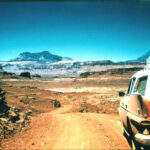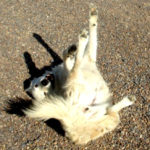
Canyon Surveys was the name a trio of Glen Canyon adventurers gave themselves to reflect their passion for discovery and documentation of the outstanding geography, history, prehistory, and scenic wonders of the place. They consisted of Dick Sprang and his wife, Dudy Thomas, of Sedona, Arizona, and veteran river man Harry Aleson of Richfield, Utah. Two four-legged companions accompanied them, as Dick described in his always eloquent way:
“Two additional members of our party […] may surprise you: Pard: my splendidly level-headed shepherd dog—in the tradition of Ed Meskin’s dog—and Mickey, Dudy’s supremely tough, gray and white, short-haired tomcat, who was built like a buffalo, had the heart of a lion, and walked the canyons, wading water, with a tiger’s stride, utterly fearless, militant, shrewd, never a problem, always keeping up, and thoroughly at home loving to doze in Anasazi ruins. We called him our Moki Cat. So far as we know, nobody else ever took such an unlikely character down Glen Canyon and up many of its tributaries on four separate trips. If you have wondered if we three were somewhat crazy, your suspicions stand confirmed.”
Dick had enlarged the prehistoric steps, and, with the aid of ropes, a harness for Pard, and a fishing creel to hoist Mickey, they all made it into the upper canyon where they spotted the dwelling. Dick was thrilled.
Read more →










